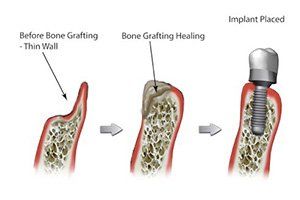Bone Grafting/ Crown Length
Bone Grafting
Bone loss to the jaw is one of the most serious consequences of missing teeth. It begins as soon as a tooth is lost, when the natural stimulation for bone growth created by the force of teeth chewing can no longer occur. The result can be dramatic.
Fortunately, excessive bone loss isn’t inevitable if you lose a tooth. Dentists can perform bone grafting procedures with materials that stimulate new bone growth at the missing tooth site. And, if placed immediately after a tooth
extraction, grafting can prevent excessive bone loss and allow for future dental implants to be placed.
Bone grafts are derived from one of four possible sources: the patient, another human being, an animal or synthetic materials. The source used will depend on whichever the dentist believes will work best in the patient’s situation. Donor tissue from another person or animal is thoroughly disinfected and safe for grafting.
The graft itself acts more as a platform for nearby bone to grow upon; the new bone growth will eventually replace the graft material, which is made up of the minerals calcium, phosphorous and hydroxyapatite. The dentist may also cover the graft with collagen membranes to guide the regeneration, or synthetic material that acts with other biologically active molecules in the body to promote healing. These materials are eventually absorbed by the body.
It is no secret that dentists are committed to saving teeth. This is why we fill a cavity, instead of pulling the tooth.
Crown Lengthening
Crown lengthening is done when a tooth needs to be fixed. Sometimes, not enough of the tooth sticks out above the gum to support a filling or crown.
This can happen when a tooth breaks off at the gum line. It also can happen when a crown or filling falls out of a tooth and there is decay underneath. To place a filling or crown, your dentist needs to expose more of the tooth. This is done by removing some gum tissue or bone. Some people have a lot of gum tissue around their upper teeth. also known as "gummy smile." This also can be treated with crown lengthening.
Dr. Abdelrazek uses Laser to increase precision and minimize pain and recovery time.
Copyright © 2019 Potomac Falls Family Dentistry - All Rights Reserved


